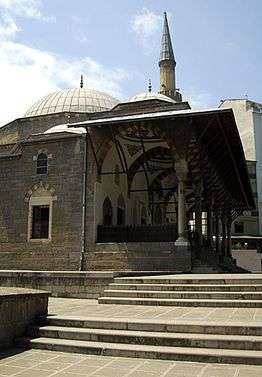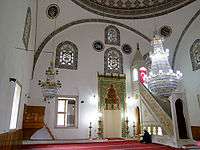Gülbahar Hatun
| Gülbahar (Kül-Bahār) Hatun گل بهار خاتون | |
|---|---|
|
The tomb of "Gülbahar Hatun" is located inside "Gülbahar Hatun Mosque" in Trabzon | |
| Born |
Ayşe (A'ishā) c. 1453 Elbistan, Dulkadir Principality |
| Died |
c. 1505 Trabzon, Ottoman Empire |
| Resting place | Gülbahar Hatun Camii, Trabzon |
| Residence | Amasya, Trabzon |
| Ethnicity | Turkish |
| Known for | Valide Sultan |
| Religion | Islam |
| Spouse(s) | Bayezid II |
| Children | Selim I |
| Parent(s) | The daughter of ’Ala ud-Daula Bozkurd Bey (Alaüddevle Bozkurt Bey), the eleventh ruler of the Dulkadirids |
Gülbahar (Kül-Bahār) Hatun (fully Devletlu İsmetlu Gülbahar Hatun Hazretleri; Ottoman Turkish: گل بهار خاتون; c. 1453 – c. 1505[1]), also known as A'ishā (Ayşe) Khātun[2] was the fourth wife of Ottoman Sultan Bayezid II and the mother of Sultan Selim I of the Ottoman Empire.[3]




Origins
Gülbahar Hatun and Ayşe Hatun were never different women. The theory of Gülbahar Hatun's origins make her a different women from Ayşe Hatun as both women had same maiden name, Ayşe in both the origins and were also married in the same year. The theories of her background are:
- The Ottoman inscription (vakfiye) describes her as Hātun binti Abd-us-Samed (Daughter of Abd-us-Samed), which supports the widespread view that her father was a Pontic Greek who had "turned Turk", that is converted to Islam and joined the Turkish Millet. Abd-us-Samed, meaning Servant of God, was the anonym that was applied to many Balkan and Anatolian Christians who converted to Islam in the classical Ottoman period.[1][4][5]
The origin described above is also described for Emine Gülbahar Hatun, wife of Mehmed the Conqueror, mother of Sultan Bayezid II and the grandmother of Sultan Selim I. The origin described below is the most acceptable origin of Gülbahar Hatun.
- According to this origin (most sources have claimed that) she was the daughter of Alaüddevle Bozkurt Bey, the eleventh ruler of the Dulkadirids centered around Elbistan in Kahramanmaraş. Her real name was Ayşe and was renamed Gülbahar after her marriage.[6][7][8][9][10][11][12][13][14][15]
Life
Bayezid married her in 1469 at Amasya. When Bayezid was still a şehzade ("Ottoman prince") and the governor of Amasya sanjak when she gave birth to Selim I in 1470.[1] When Mehmed the Conqueror died in 1481, Bayezid moved to Constantinople, the capital of the Ottoman Empire, along with his family to ascend the throne.[1]
According to Turkish tradition, all princes were expected to work as provincial governors (Sanjak-bey) as a part of their training.[14] Mothers of princes were responsible for the proper behaviour of their sons in their provincial posts.[14] In 1495 was sent to Trabzon sanjak and then in 1511 to Samandıra, and Gülbahar accompanied him.[1]
However, she herself never became recognized as a Valide Sultan because she died in 1505 before Selim's accession to the sultanate.[16] Her tomb is located in Gülbahar Hatun Camii, Trabzon.[14] It was built in 1514 in honour of his mother and was restored in 1885.[17]
See also
- Ottoman Empire
- Ottoman family tree
- Ottoman dynasty
- Line of succession to the Ottoman throne
- Ottoman Emperors family tree (simplified)
Further reading
- Peirce, Leslie P., The Imperial Harem: Women and Sovereignty in the Ottoman Empire, Oxford University Press, 1993, ISBN 0-19-508677-5 (paperback).
- Yavuz Bahadıroğlu, Resimli Osmanlı Tarihi, Nesil Yayınları (Ottoman History with Illustrations, Nesil Publications), 15th Ed., 2009, ISBN 978-975-269-299-2 (Hardcover).
References
- 1 2 3 4 5 "Turkey: The Imperial House of Osman". web.archive.org. Retrieved 6 February 2014.
- ↑ Yavuz Bahadıroğlu, Resimli Osmanlı Tarihi, Nesil Yayınları (Ottoman History with Illustrations, Nesil Publications), 15th Ed., 2009, page 157, ISBN 978-975-269-299-2
- ↑ Ahmed Akgündüz, Said Öztürk (2011). Ottoman History: Misperceptions and Truths. Oxford University Press. ISBN 978-9-090-26108-9.
- ↑ "Consorts Of Ottoman Sultans (in Turkish)". Ottoman Web Page.
- ↑ Anthony Dolphin Alerson (1956). The Structure of the Ottoman Dynasty. Clarendon Press.
- ↑ "Yavuz Sultan Selim Han". Republic of Turkey Ministry of Culture and Tourism. Retrieved 2009-02-06.
- ↑ "Mother Of Yavuz Sultan Selim". Osmanlı Araştırmaları Vakfı (Ottoman Research Foundation).
- ↑ Osmanlıdan Cumhuriyete Trabzonlu simalar ve Trabzon'un köklü aileleri. Mehmet Akif Bal. 2005. ISBN 978-9-750-04510-3.
- ↑ Yakın Çağda Kahramanmaraş. Ukde. 2009. ISBN 978-6-055-60205-5.
- ↑ Zamanın İskenderi şarkın Fatihi: Yavuz Sultan Selim. Yitik Hazine Yayınları. 2010. ISBN 978-9-944-76624-1.
- ↑ VII-XVI. asırlarda Maraş emirleri: emir, melik, bey, senyör, beylerbeyi, sancakbeyi. Ukde. 2008. ISBN 978-6-058-99710-3.
- ↑ Amasya. Amasya Ticaret ve Sanayi Odası. 1997.
- ↑ Türk dünyası araştırmaları, Issue 153. Türk Dünyası Araştırmaları Vakfı. 2004.
- 1 2 3 4 Leslie P. Peirce (1993). The Imperial Harem: Women and Sovereignty in the Ottoman Empire. Oxford University Press. pp. 106–107. ISBN 978-0-195-08677-5.
- ↑ Dijkema, F.TH (1977), The Ottoman Historical Monumental Inscriptions in Edirne, BRILL, p. 32, ISBN 9004050620
- ↑ Mausoleum of Gülbahar Hatun (Ayşe Hatun)
- ↑ Description about Gülbahar Hatun (Ayşe Hatun) Mosque


